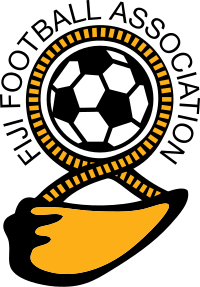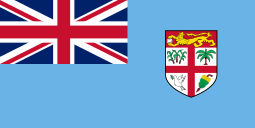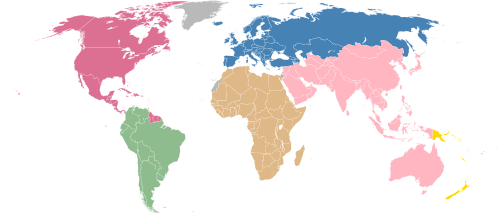Fiji Football Association
The Fiji Football Association is the governing body of football in Fiji. It came into existence in 1961, replacing the ethnically based Fiji Indian Football Association. The Indian Association was formed in 1938 but football in Fiji had a much humbler beginning.
| OFC[1] | |
|---|---|
 | |
| Founded | 1938 |
| Headquarters | Suva |
| FIFA affiliation | 1964 |
| OFC[2] affiliation | 1966 |
| President | Rajesh Patel |
| Website | http://www.fijifootball.com.fj |
History of Fijian football
Football started to be played in Fiji ever since the arrival of Europeans in Fiji and establishment of towns like Levuka where significant numbers of sports enthusiasts could congregate and socialise with a friendly game. Missionaries, who established schools in Fiji, introduced football as part of the school program and football was being played in schools as early as 1889. The Suva Soccer Football Club was formed in 1905, made up of European employees of the Government and businesses and similar clubs existed in Nausori and Levuka. In 1910, a team representing Suva played a match against a team representing Nausori. Crew of visiting naval ships also entertained themselves with friendly games of football with local teams. In 1910 a team from Suva played a game against a team from HMS Powerful and won 3 goals to 1. In 1914, a team from Suva played against a team from HMS Torch, at Albert Park, and won by 2 goals to nil.
Native Fijian football
Fijian teams started playing competitive football in 1924. The first Fijian Inter-District Tournament was played at Nasau Park, Levuka, during celebrations marking the golden jubilee of Cession in 1924. Teams played for the Ricarnie Cup which was won by the Sawani team from Naitasiri. The following year, Bau won the cup. Players played the game barefoot and relied on speed and stamina. Other teams to compete in the tournament were Shamrock from Suva, Kadavu (from Suva), Lomaiviti (from Suva) and Ovalau (from Levuka).
Meanwhile, football was also being played by Fijians in Lautoka. A Friday and Saturday league was organised at the Veitari Grounds and teams that took part were Namoli, Vitogo, Vakabuli, Saru, Yalobi (from Waya), Kadavu, Vanua Levu and Topline. The Namoli Native Soccer Club won the league nine times in a row between 1941 and 1949. A prominent member of the club was Ratu Meli Qoro, who also acted as an official and referee at tournaments. He had learnt to play football at the local Methodist Mission Primary school. In the northern division, football was played between the Wainikoro and Waibula District Fijian Schools in 1938.
The success of Fijians at rugby, tempered their enthusiasm for football and the physical nature of rugby appealed to them and gradually organised football amongst the Fijians died out.
Fiji Indians take up football
Schools run by missionaries, also taught students to play football. Brother Mark, a Marist missionary from New Zealand introduced football to Marist Brothers Indian School in Toorak, Suva and organised games with students from other schools. As the students grew up and left school, they started playing football socially on their own.
When the Colonial Sugar Refining Company(CSR) set up sugar mills in Fiji it also set aside land for recreational activities. Some mill managers actively encouraged workers and farmers to play the game. The Nausori mill manager provided a full sized playing field in 1925 and in the 1930s erected temporary enclosure to enable the collection of entrance fees during tournaments. In Ba, the mill manager provided a trophy, in the 1930s, for the local league competition. In 1930, the Governor made available two playing fields in Suva for use in football competitions. In 1922, the Sunshine Club was established in Suva and the Sitare Hind (Stars of India) club established in Rewa. These two teams played each other on a regular basis. Gradually other teams, like Morning Star, Nausori Central, Vuci and Wainibokasi, were established in Rewa and played at the Dilkusha Grounds. There were also four teams in Suva who played at the Marist Brothers School grounds in Toorak.
The first football association
The Indian Reform League was the first to form an association to organise football in Fiji. The league was made up educated Fiji Indians and many of its members had links to the Christian churches in Fiji. In addition to football, it also organised cricket, hockey and lawn-tennis. In December 1927, the league organised a schools football competition at Albert Park. Schools that took part in it were Methodist Mission School, Marist Brothers School, Munivatu Indian School and Islamia School. Buoyed by the success of this tournament, the league met on 22 January 1928 and formed a Football Association committee. The editor of the monthly Hindi/English magazine, Vriddhi, Dr I.H. Beattie donated a trophy and the first competition was organised on 26 May 1928 at the Marist Brothers School ground. The teams that took part were Indian Reform League Football Club, Toorak Service Club, Dilkusha Excelsior Football Club, Rewa Football Club and the Union Club. Dilkusha Excelsior won the competition for the first three years. In 1936, the association was renamed, the Suva Football Association. The number of teams grew to 8 in 1936, 16 in 1945 and 41 in 1958 with competition being organised in senior, reserve, intermediate and junior grades.
Football associations around Fiji
Rewa started its own league in 1928 and the Rewa United Football Club was formed to take part in the Vriddhi Cup Tournament. The other team from Rewa was the Dilkusha Excelsior. In 1937 the Rewa Indian Football Association was formed. In Ba, efforts by Pundit Ami Chandra, with support from CSR led to the formation of the Ba Indian Football Association in 1935. The local league had four teams in 1940. In Lautoka, John Bairangi led the formation of the Lautoka Soccer Football Association in 1934. Initially there were two teams, Namoli Indian Sports and Service. Levuka had an organised local competition in 1932 and these clubs formed the Levuka Indian Soccer Association in 1938. The Nadi Indian Soccer Association was formed in 1937 with four teams: Koronubu, Sabeto, Bhartiya and Vutualevu. From 1940 the football playing districts of the western division, played for the Caine’s Cup.
Fiji Indian Football Association
The formation of Fiji Indian Football Association was proposed by Arthur Stanley Farebrother, a Suva businessman. As the teams from Suva, Rewa, Ba, Levuka and Lautoka gathered in Suva for an inter-district tournament, a meeting was organised on 8 October 1938 in the office of A.S. Farebrother and Company and the Fiji Indian Football Association was formed to organise and control football in Fiji. A.S. Farebrother was its first President. The first inter-district football tournament was held in Suva on 9 and 10 October 1938 for the Lloyd - Farebother trophy donated by Lloyd and Company and A.S. Farebrother and Company. Rewa won the first competition by defeating Ba by 3 goals to 2.
The constitution of the Association was adopted at a meeting in Lautoka on 22 April 1939. The following year Nadi, Nadroga and Rakiraki also joined the Association. During the war years there was no dampening of interest in football in Fiji, which saw the domination of the inter-district competition by three teams: Rewa (which won in 1938, 1939, 1943 & 1944), Suva (which won in 1940 & 1945) and Lautoka (which won in 1941 & 42). In 1943 Navua and Tailevu/Naitasiri also joined the Association and Taveuni joined in 1947. In 1958, when the association celebrated its 21st inter-district tournament, 14 districts took part. It is important to note that in 1963, a rival Association was being formed and the then Secretary Mr. D.S. Naidu, from Lautoka in consultation With M Vasagam Pillay the President, decided to register with FIFA. The difficulty was that Fiji FA during this time also had the acronym FIFA (Fiji Indian Football Association). FIFA did not mind so much the acronym but objected to the racial connotation Indian. D S Naidu sent a cablegram in reply agreeing to change the name to Fiji Football Association. Thus the name change occurred and FIFA became FFA and attained the membership of Federation de International de Football Association. This change in status gave FFA the sole right of controlling organised soccer Football in Fiji.
Competitions organised
From 1942, Suva and Rewa played yearly for the King Irving Cup. From 1949 all teams in the southern district played for the McIlwain Cup. In the west, the regional competition continued for the new Lautoka General Transport Trophy, until 1977. The Fiji Secondary Schools Soccer Association was formed in 1950 and from 1951 regular secondary school competitions have been organised. These tournaments were dominated by Natabua High School of Lautoka, Xavier College of Ba, Shri Vivekananda High School of Nadi and DAV Boys, Indian High and Marist of Suva. In 1975, the Fiji Primary Schools Soccer Association was formed to organise competitions for primary school students.
Lautoka dominated Fiji football in the late fifties by winning three inter-district tournaments in a row (1957–1959) and four North-West Tournaments in a row (1957–1960). It also had numerous wins against Suva for the annual Pala Cup and against Ba for the Sugar Cup.
Formation of multi-racial association
After many years of discussion, and stiff opposition from some quarters, it was decided in August 1961 to remove the word “Indian” from the title of the Fiji Indian Football Association, thus forming the Fiji Football Association – a truly multiracial and national body. With this new status Fiji’s football team participated in first South Pacific Games held in Suva in 1963. The opening up of football to all races saw teams like Ba immediately benefiting from the new arrangement. Football in Ba had long enjoyed support from the Fijian community and Ba soon had some good and famous Fijians playing in its team. Suva’s multiracial population also provided early opportunity for people of other races to join the football competitions.
Football in Fiji in the sixties
Football in Fiji was dominated by the Ba team in the sixties. In the sixties Ba won the inter-district football tournament five times, the last three in a row from 1966 to 1968. Ba also won the North-west football tournament and the Sugar Cup. In 1968, the Fiji Football Association adopted a two tier system where Ba, Labasa, Lautoka, Nadi, Rakiraki, Rewa, Sigatoka and Suva were placed in division A and Levuka, Tailevu-Naitasiri, Tailevu North, Savusavu, Taveuni and Navua were placed in division B. Division B competed for the Fiji Football Association Cup, won for the first time by Levuka. At the end of the season there were promotion-relegation matches. In 1969 the inter-district football tournament was held in Labasa for the first time and Nadi won the trophy for the first time.
Football in Fiji in the seventies
In the 1970s, the association was able to convince town councils to build permanent seating structures and grounds for football and by the late nineties all A division teams, except two had such facilities. From 1976 pool play was introduced into the inter-district football tournament. Regular district level competitions were organised with the formation of the National League in 1977. The Battle of Giants tournament started in 1978. A Girmit Tournament was organised in 1979 to celebrate the centenary of the arrival of the Indians.
Football in Fiji in the eighties
In 1980, the Fiji Football Association acquired its own building, which is being used as an administration centre. For the first time since 1938, the inter-district football tournament was not held in 1987. This was due to uncertainties following the coup and restrictions on playing football on Sundays. 1988 was the golden jubilee year for the association as football in Fiji learnt to perform under the new post-coup conditions.
The nineties and beyond
Football is now well established in Fiji with people of all races taking part. Facilities for players have been greatly improved and the Fiji national side regularly takes part in international tournaments.[3][4][5][6]
List of affiliated districts
- Ba Football Association
- Bua Soccer Association
- Dreketi Soccer Association
- Labasa Soccer Association
- Lami Soccer Association
- Lautoka Football Association
- Levuka Soccer Association
- Nadi Soccer Association
- Nadogo Soccer Association
- Nadroga Soccer Association
- Nalawa Soccer Association
- Nasinu Football Association
- Navua Soccer Association
- Rakiraki Football Association
- Rewa Soccer Association
- Savusavu Soccer Association
- Seaqaqa Soccer Association
- Suva Soccer Association
- Tailevu/Naitasiri Football Association
- Tailevu North Soccer Association
- Taveuni Soccer Association
- Tavua Soccer Association
- Vatukoula Football Association[7]
List of associate members
- Fiji Football Coaches Association
- Fiji Football Referees Association
- Fiji Gujerati Sports Association
- Fiji Muslim Sports Association
- Fiji Primary Schools Football Association
- Fiji Secondary Schools Football Association
List of tournaments
- Inter-district Championship
- National Soccer League
- Battle of the Giants
- Champion versus Champion
- Fiji Football Association Cup Tournament
- National Club Championship
- Girmit Soccer Tournament
FIFA World Cup qualification (OFC)
List of presidents
- Arthur Stanley Farebrother 1938 - 1940
- Tulsi Ram Sharma 1940 - 1945, 1948–1950, and 1954
- Dwarka Prasad 1945 - 1947
- Andrew Indar Narayan Deoki 1951 - 1953, 1955–1958
- F.M.K. Sherani 1954 - 1955
- Justice Sir Moti Tikaram 1959 - 1960
- Abdul Lateef 1960–1962, 1966–1967
- Manikam V. Pillai 1962–1965, 1967–1983
- Hari Pal Singh 1983–1985
- Dr M.S. Sahu Khan 1985 -
- Rajesh Patel 2010 -2015
References
- "Living in the Dark Age - Fiji Times Online". Fijitimes.com. 2008-12-22. Archived from the original on 2013-12-12. Retrieved 2013-12-04.
- "Living in the Dark Age - Fiji Times Online". Fijitimes.com. 2008-12-22. Archived from the original on 2013-12-12. Retrieved 2013-12-04.
- "Fiji FA records $30,000 loss - Fiji Times Online". Fijitimes.com. Archived from the original on 2013-12-12. Retrieved 2013-12-09.
- "Fiji soccer drops to 191, Fiji FA claims world ranking not a true indicatior of soccer standard". Fijiworldnews.com. Retrieved 2013-12-09.
- Mon Oct 28, 2013 (2013-10-28). "FBC News". Fbc.com.fj. Retrieved 2013-12-09.
- "$5m boost for Fiji FA". Fijisun.com.fj. 2013-11-30. Retrieved 2013-12-09.
- "FIJI FA District Affiliates".
External links
- Official website
- Fiji at the FIFA website.
- Fiji at OFC site
Bibliography
- M. Prasad, Sixty Years of Soccer in Fiji 1938–1998: The Official History of the Fiji Football Association, Fiji Football Association, Suva, 1998.

